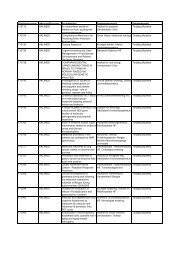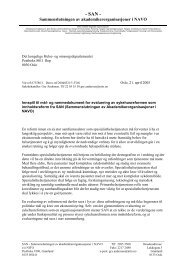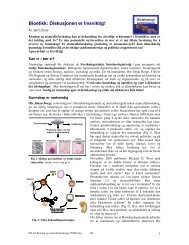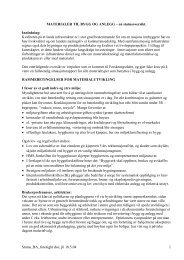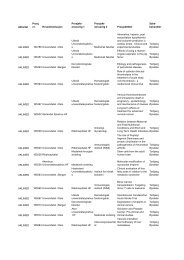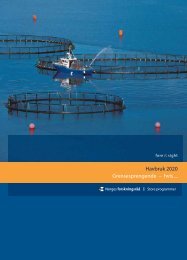A Revolution in R&D
A Revolution in R&D
A Revolution in R&D
Create successful ePaper yourself
Turn your PDF publications into a flip-book with our unique Google optimized e-Paper software.
30<br />
Efficiency improvements <strong>in</strong> target discovery account<br />
for the rema<strong>in</strong><strong>in</strong>g sav<strong>in</strong>gs.<br />
The Uncerta<strong>in</strong>ty<br />
For these vast sav<strong>in</strong>gs to materialize, two requirements<br />
will have to be met. First, disease genetics<br />
must prove scientifically feasible for the relevant<br />
common diseases. Second, not only must studies <strong>in</strong><br />
humans work; <strong>in</strong> addition, the targets they identify<br />
must be drugable; fail<strong>in</strong>g that, identify<strong>in</strong>g the disease<br />
genes is po<strong>in</strong>tless, and all the effort that has<br />
gone <strong>in</strong>to f<strong>in</strong>d<strong>in</strong>g them will be wasted. (See sidebar,<br />
“Drug-Resistant?—Are Disease Genes Drugable<br />
Targets?”)<br />
Feasibility—the Limitations of Technology<br />
Fundamental technological concerns still hover over<br />
disease genetics. Can it actually be done? The results<br />
so far have been very modest. The bonanza of<br />
clearly documented disease-susceptibility genes for<br />
common multigenic diseases has yet to materialize.<br />
Candidate gene studies, for <strong>in</strong>stance, are by def<strong>in</strong>ition<br />
limit<strong>in</strong>g: they focus on a subset of genes def<strong>in</strong>ed<br />
by a prior hypothesis, and therefore risk exclud<strong>in</strong>g<br />
some crucial culprits. And genome-wide l<strong>in</strong>kage<br />
studies, although highly successful <strong>in</strong> address<strong>in</strong>g<br />
s<strong>in</strong>gle-gene diseases, have proved disappo<strong>in</strong>t<strong>in</strong>g for<br />
DRUG-RESISTANT?—ARE DISEASE GENES DRUGABLE TARGETS?<br />
The skeptics pose an awkward question: Will disease-related<br />
genes ever prove to be drugable <strong>in</strong> significant<br />
numbers? The record so far is hardly encourag<strong>in</strong>g.<br />
Some disease genes, such as CFTR <strong>in</strong> cystic<br />
fibrosis, were identified long ago, yet have failed to<br />
generate therapeutics. The <strong>in</strong>frequency of success<br />
stories, such as Ceredase—a drug for type I<br />
Gaucher’s disease that was essentially a creation of<br />
disease genetics—only highlights the general trend<br />
of failure.<br />
These long-identified disease genes tend to be for<br />
s<strong>in</strong>gle-gene disorders, however. And such disorders<br />
are by their nature difficult to cure. They are b<strong>in</strong>ary<br />
phenomena: the gene is broken, you get the disease.<br />
the more common multigenic k<strong>in</strong>d of disease: a disease-related<br />
gene might be accurately p<strong>in</strong>po<strong>in</strong>ted <strong>in</strong><br />
affected families (such as the BRCA1 breast cancer<br />
susceptibility gene), only for it then to show very low<br />
prevalence outside the families used <strong>in</strong> identify<strong>in</strong>g<br />
it. True, these two approaches might become more<br />
tractable now, <strong>in</strong> the wake of the sequenc<strong>in</strong>g of the<br />
human genome and the development of comprehensive<br />
SNP maps (catalogs of the characteristics<br />
and locations of SNPs <strong>in</strong> the genome).<br />
As for genome-wide association studies, considered<br />
by many experts to be the most promis<strong>in</strong>g of all,<br />
they have only recently became practicable: all the<br />
requisite tools (a full genome sequence with a SNP<br />
map to match, genotyp<strong>in</strong>g technologies, and so on)<br />
appear to be <strong>in</strong> place. But the approach rema<strong>in</strong>s virtually<br />
untested, ow<strong>in</strong>g to the still exorbitant cost of<br />
genotyp<strong>in</strong>g. The preferable form of genome-wide<br />
association studies would clearly be the <strong>in</strong>direct<br />
k<strong>in</strong>d—still cover<strong>in</strong>g the entire genome, but genotyp<strong>in</strong>g<br />
far fewer SNPs—yet even here the current<br />
cost is a prohibitive $400 million or so for each disease<br />
<strong>in</strong>vestigated. With<strong>in</strong> five years, however, genotyp<strong>in</strong>g<br />
costs are expected to fall to $20 million or<br />
less, and the essential proof-of-concept tests can<br />
then take place more rout<strong>in</strong>ely. (See sidebar,<br />
F<strong>in</strong>d<strong>in</strong>g a small-molecule therapeutic to repair a completely<br />
defective prote<strong>in</strong> is an extremely difficult challenge.<br />
(Indeed, Ceredase is a prote<strong>in</strong> therapeutic.)<br />
Most disorders, by contrast, are attributable not to a<br />
s<strong>in</strong>gle gene but to multiple genes, and perhaps other<br />
factors too. This means that the system as a whole<br />
can still function, just hampered to a greater or<br />
lesser degree. Such cases benefit from patch<strong>in</strong>g up,<br />
so drugs can be beneficial without actually constitut<strong>in</strong>g<br />
a cure. There is little reason to doubt that<br />
such palliative drugs will soon emerge <strong>in</strong> abundance,<br />
as disease genetics becomes ever faster at<br />
identify<strong>in</strong>g some of the genes implicated <strong>in</strong> multigenic<br />
disorders.



